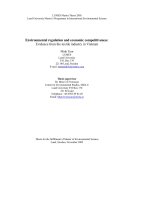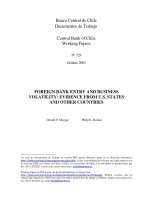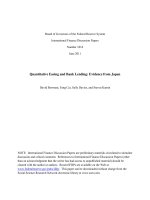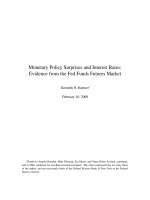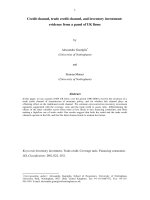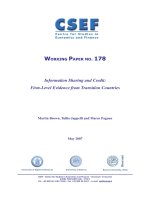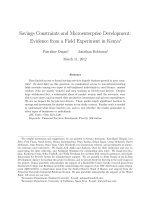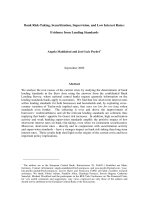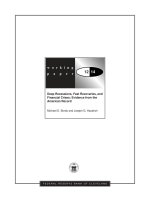Information Sharing and Credit: Firm-Level Evidence from Transition Countries ppt
Bạn đang xem bản rút gọn của tài liệu. Xem và tải ngay bản đầy đủ của tài liệu tại đây (330.82 KB, 42 trang )
W
W
O
O
R
R
K
K
I
I
N
N
G
G
P
P
A
A
P
P
E
E
R
R
N
N
O
O
.
.
1
1
7
7
8
8
Information Sharing and Credit:
Firm-Level Evidence from Transition Countries
Martin Brown, Tullio Jappelli and Marco Pagano
May 2007
University of Naples Federico II
University of Salerno
Bocconi University, Milan
CSEF - Centre for Studies in Economics and Finance – UNIVERSITY OF SALERNO
84084 FISCIANO (SA) - ITALY
Tel. +39 089 96 3167/3168 - Fax +39 089 96 3167 – e-mail:
W
W
O
O
R
R
K
K
I
I
N
N
G
G
P
P
A
A
P
P
E
E
R
R
N
N
O
O
.
.
1
1
7
7
8
8
Information Sharing and Credit:
Firm-Level Evidence from Transition Countries
Martin Brown
*
, Tullio Jappelli
**
and Marco Pagano
***
Abstract
We investigate whether information sharing among banks has affected credit market performance in the
transition countries of Eastern Europe and the former Soviet Union, using a large sample of firm-level data. Our
estimates show that information sharing is associated with improved availability and lower cost of credit to
firms, and that this correlation is stronger for opaque firms than transparent firms. In cross-sectional estimates,
we control for variation in country-level aggregate variables that may affect credit, by examining the differential
impact of information sharing across firm types. In panel estimates, we also control for the presence of
unobserved heterogeneity at the firm level and for changes in selected macroeconomic variables.
Keywords: information sharing, credit access, transition countries
JEL Classification: D82, G21, G28, O16, P34
Acknowledgements: We benefited from the comments of Mariassunta Giannetti, Luigi Pistaferri, Alessandro
Sembenelli, Greg Udell and seminar participants at the University of Turin, the Swiss National Bank, the
Ancona Conference on the Changing Geography of Banking, the 8
th
Conference of the ECB-CFS Research
Network on Financial Integration and Stability in Europe, and the 2007 Skinance conference. We also thank
Caralee McLiesh of the World Bank and Utku Teksov of the EBRD for kindly providing us with data, Lukas
Burkhard for research assistance and the Unicredit Group for financial support.
*
Swiss National Bank (e-mail: )
**
University of Naples Federico II, CSEF and CEPR (e-mail: )
***
University of Naples Federico II, CSEF and CEPR (e-mail: )
Contents
1 Introduction
2 Effects of Information Sharing
2.1 Theory
2.2 Empirical Evidence
3 Data
3.1 Information Sharing
3.2 Credit Access
3.3 Regression Specification
4 Cross-sectional Estimates
5 Panel Estimates
6 Conclusions
References
Appendix
7
1 Introduction
When banks evaluate a request for credit, they can either collect information on the
applicant first-hand or source this information from other lenders who already dealt with the
applicant. Information exchange between lenders, can occur voluntarily via “private credit
bureaus” or be enforced by regulation via “public credit registries”, and is arguably an
important determinant of credit market performance. Theory suggests that information
sharing may overcome adverse selection in the credit market (Pagano and Jappelli, 1993) and
reduce moral hazard, by motivating borrowers to exert high effort in projects and repay loans
(Padilla and Pagano, 2000). Empirical work has identified a positive correlation between
measures of information sharing, aggregate credit and default risk (Jappelli and Pagano, 2002;
Djankov, McLiesh and Shleifer, forthcoming).
Information sharing should be particularly relevant for credit market performance in
countries with weak company law and creditor rights. Lack of transparency in corporate
reporting, due to weak company law, increases information asymmetries in the borrower-
lender relationship, reducing incentives for banks to lend. Moreover, weak creditor rights
make banks more reluctant to lend to risky firms, as contract enforcement is costly or
impossible. The screening and incentive effects of information sharing can mitigate both of
these problems.
In this paper we attempt to shed light on the role of information sharing in countries with
weak company law and creditor rights. We analyze the impact of private credit bureaus and
public credit registries on the availability and cost of credit to firms in 24 transition countries
of Eastern Europe and the former Soviet Union.
1
Pistor, Raiser and Gelfer (2000) document
that in these countries the legal environment is particularly unfavourable for lending.
Moreover, transition countries are an interesting sample to study because some of them have
recently experienced both strong credit market development and considerable institutional
change, including the introduction of information sharing systems. Private sector credit has
1
We examine data from 24 transition countries, which we classify into three groups according to their
status in 2005: European Union (Czech Republic, Estonia, Hungary, Latvia, Lithuania, Poland, Slovak
Republic, Slovenia); Commonwealth of Independent States (Armenia, Azerbaijan, Belarus Georgia,
Kazakhstan, Kyrgyzstan, Moldova, Russia, Ukraine); Other European Countries (Albania, Bosnia &
Herzegovina, Bulgaria, Croatia, Macedonia, Romania, Serbia & Montenegro). We exclude the CIS
countries Tajikistan, Turkmenistan and Uzbekistan due to lack of data.
8
climbed from just 15% of GDP in 1999 to 25% at the end of 2004.
2
The quality of lending has
also strongly improved, with the ratio of non-performing loans in banks’ portfolios falling
from more than 20% in 1999 to just 10% at the end of 2004. Over the same period, seven
public registries and seven private credit bureaus have emerged in these countries.
To measure credit market performance, we use firm-level data on credit access and cost of
credit, drawn from the EBRD/World Bank “Business Environment and Enterprise
Performance Survey” (BEEPS), a representative and large sample of firms. We relate this
firm-level credit data to country-level indicators of information sharing, compiled from the
“Doing Business” database of the World Bank/IFC (World Bank, 2006).
There are two main benefits from investigating the impact of information sharing using our
data set. First, firm-level data allow us to identify the firms that benefit more from
information sharing arrangements. For instance, firms that are opaque and costly to screen
may gain greater access to credit after the introduction of a credit registry or bureau. We can
thus overcome the limitations of aggregate data, which confound the effect of information
sharing on individual firms with that arising from compositional changes in the set of firms
who obtain credit. The second reason for using the BEEPS data is methodological: it allows
us to control for unobserved heterogeneity at the firm level and for changes in other
macroeconomic variables, using panel data constructed from the 2002 and 2005 surveys. As
far as we are aware, this is the first study to use firm-level panel data to investigate the
relation between information sharing and credit availability. Previous analyses are either
based on country-level data (Jappelli and Pagano, 2002; Djankov et al., forthcoming) or on
cross-sectional firm-level data (Galindo and Miller, 2001; Love and Mylenko, 2003).
Both our cross-sectional estimates and our panel estimates show that on average
information sharing is associated with more abundant and cheaper credit. Moreover, the
cross-sectional correlation between credit availability and information sharing is stronger for
opaque firms than transparent ones, where transparency is defined as the reliance on external
auditors and the adoption of international accounting standards. Panel estimates also suggest
that small firms benefit more from information sharing than larger ones. Taken together, these
two results are consistent with the view that information sharing is particularly valuable in
guiding banks to evaluate credit applicants who would otherwise be too costly to screen.
2
The statistics in this paragraph are unweighted country averages, drawn from the EBRD Transition
Report (EBRD, 2003; EBRD, 2005).
9
Finally, our evidence confirms previous findings that information sharing is more effective in
countries with weaker legal environments.
The rest of the paper is organized as follows. Section 2 provides a literature review and
presents the hypotheses to be tested. Section 3 describes the data and the specification to be
estimated. Sections 4 and 5 present the results obtained with cross-sectional and panel data,
respectively. Section 6 summarizes our findings.
2 Effects of Information Sharing
In this section we review the models proposed in the literature to capture the effects of
information sharing on credit market performance, using them to draw testable predictions for
our empirical analysis. We also set our work against the existing empirical evidence in this
area, to highlight the value added of our contribution.
2.1 Theory
By exchanging information about their customers, banks can improve their knowledge of
applicants’ characteristics, past behavior and current debt exposure. In principle, this
reduction of informational asymmetries can reduce adverse selection problems in lending, as
well as change borrowers’ incentives to repay, both directly and by changing the
competitiveness of the credit market. It can also reduce each bank’s uncertainty about the total
exposure of the borrower, in the context of multiple-bank lending. The implied effects on
lending, interest rates and default rates have been modeled in several ways.
3
Pagano and Jappelli (1993) show that information sharing reduces adverse selection by
improving bank’s information on credit applicants. In their model, each bank has private
information about local credit applicants, but no information about non-local applicants. If
banks exchange information about their client’s credit worthiness, they can assess also the
quality of non-local credit seekers, and lend to them as safely as they do with local clients.
The impact of information sharing on aggregate lending in this model is ambiguous. When
3
See Jappelli and Pagano (2006) for a comprehensive overview of theory and evidence on information
sharing.
10
banks exchange information about borrowers’ types, the increase in lending to safe borrowers
may fail to compensate for an eventual reduction in lending to risky types.
Information sharing can also create incentives for borrowers to perform in line with banks’
interests. Klein (1982) shows that information sharing can motivate borrowers to repay loans,
when the legal environment makes it difficult for banks to enforce credit contracts. In this
model borrowers repay their loans because they know that defaulters will be blacklisted,
reducing external finance in future. Vercammen (1995) and Padilla and Pagano (2000) show
that if banks exchange information on defaults, borrowers are motivated to exert more effort
in their projects. In both models default is a signal of bad quality for outside banks and carries
the penalty of higher interest rates, or no future access to credit. Padilla and Pagano (1997)
show that information sharing can also mitigate hold-up problems in lending relationships, by
eliciting more competition for borrowers and thereby reducing the informational rents that
banks can extract. The reduced hold-up problems can elicit higher effort by borrowers and
thereby make banks willing to lower lending rates and extend more credit.
4
Finally, when a customer can borrow from several banks, each of these may be uncertain
about the customer’s total exposure, and therefore about his ability to repay. Bennardo,
Pagano and Piccolo (2007) show that the danger of overlending that stems from this
uncertainty may result in inefficiently scarce credit. Insofar as it makes lending safer,
information sharing about seniority or debt exposure can raise investment and welfare.
Given the variety of the informational problems considered in these models, it is not
surprising that the predicted effects of information sharing on the volume of lending are not
identical across models. For instance, in the adverse selection model of Pagano and Jappelli
(1993) the effect on lending is ambiguous, while it is positive in the hold-up model of Padilla
and Pagano (1997) and in the multiple-bank lending model of Bennardo et al. (2007). The
effect on lending also depends on the type of information being shared: in the model by
Padilla and Pagano (2000), sharing only default information increases lending above the level
reached when banks also share their data about borrowers’ characteristics. Therefore, whether
information sharing is associated with increased lending is left to the empirical evidence.
4
Bouckaert and Degryse (2004) and Gehrig and Stenbacka (2007) show that if banks compete ex ante
for clients and customers face switching costs, future informational rents foster banking competition.
Since information sharing reduces these rents, in these models it reduces competition, in contrast to
Padilla and Pagano (1997).
11
In contrast, these models offer qualitatively similar predictions about the effect of
information sharing on the probability of default and interest rates: they all predict that, in one
form or another, communication among banks tends to reduce defaults and thereby
equilibrium interest rates. But this prediction is unambiguous only if referred to the
probability of default of an individual borrower. When one considers the average default rate,
composition effects may overturn the prediction. Suppose that information sharing gives
lower-grade borrowers access to credit. Even if each borrower’s probability of default is
reduced, the aggregate default rate may increase because the relative weight of lower-grade
borrowers increases in the total pool. This biases the estimates against the models’ prediction
that information sharing reduces defaults and interest rates. Thus here is an instance where, in
empirical research, borrower-level data may have an edge over aggregate measures. Being
free of these composition effects, microeconomic data allow a sharper test of this prediction.
Which firms should benefit more from information sharing between lenders? The stylized
models discussed so far offer no predictions about how information sharing affects credit
availability and interest rates depending on borrowers’ characteristics, such as firm size or
accounting standards. But such predictions can be generated by considering how these
characteristics affect the banks’ incentive to rely on information sharing rather than on direct
screening. If direct screening has fixed costs for banks, one may expect that small firms will
benefit more from information sharing. Without information sharing, banks would only offer
credit to large firms, for whom it pays to screen; with information sharing, banks can also
lend to small firms, since they can acquire information on these firms at low cost. A firm’s
informational transparency – as measured for instance by reliance on international accounting
standards or on external auditors – plays a similar role as firm size: direct screening is more
cost effective when applied to firms with more transparent accounts, so that without
information sharing these firms are more likely to get credit than opaque ones. The
introduction of information sharing will enable banks to lend more easily also to opaque
firms, by relying on non-accounting information from previous creditors.
This discussion suggests that, in addition to investigating the average effect of information
sharing on the availability and cost of credit, our firm-level analysis should also examine its
differential effect depending on firm size and transparency. We study these differential effects
by conducting sample splits based on these firm characteristics.
12
2.2 Empirical Evidence
A growing body of empirical evidence supports the hypothesis that information sharing
enhances credit market performance. Analyses of credit bureau data confirm that credit
reporting reduces the selection costs of lenders by allowing them to more accurately predict
individual loan defaults (Barron and Staten, 2003; Kallberg and Udell, 2003; Powell, Miller,
Mylenko, and Majnoni 2004; Luoto, McIntosh, and Wydick, 2004). Experimental evidence
by Brown and Zehnder (2006) shows that a public credit registry can motivate borrowers to
repay loans, when they would otherwise default.
The impact of information sharing on aggregate credit market performance has been tested
by two cross-country studies. Based on their own survey of credit reporting in 43 countries,
Jappelli and Pagano (2002) show that bank lending to the private sector is larger and default
rates are lower in countries where information sharing is more solidly established and
extensive. These cross-sectional relations persist also controlling for other economic and
institutional determinants of bank lending, such as country size, GDP, growth rate, and
variables capturing respect for the law and protection of creditor rights. Djankov et al.
(forthcoming) confirm that private sector credit relative to GDP is positively correlated with
information sharing in their recent study of credit market performance and institutional
arrangements in 129 countries for the period 1978-2003.
Firm-level data suggests that information sharing may indeed have a differential impact on
credit availability for different firm types, in line with the discussion in the previous
subsection. Love and Mylenko (2003) combine cross-sectional firm-level data from the 1999
World Bank Business Environment Survey with aggregate data on private and public
registries collected in Miller (2003). They find that private credit bureaus are associated with
lower perceived financing constraints and a higher share of bank financing, while public
credit registries are not. They also find that small and young firms benefit particularly from
information sharing.
5
Given that the above studies rely either on aggregate credit information or on cross-
sectional firm-level data, they cannot clearly disentangle the effect of information sharing
from that of firm-level characteristics and of other country-level institutional factors. By
5
Galindo and Miller (2001) also provide evidence that information sharing reduces credit constraints
at firm level. Examining balance sheet data of large companies in 23 countries they find a positive
relation between credit access and an index of information sharing.
13
relying on panel data, our paper provides the first test that controls both for unobserved firm-
level heterogeneity and for changes in other relevant country-level variables. Controlling for
the latter is especially important in the context of the rapid institutional and economic changes
experienced by transition economies.
3 Data
We draw our data from two main sources. Country level data on information sharing is
taken from the World Bank / IFC “Doing Business” database. We relate this to firm-level
information on credit availability taken from the EBRD/World Bank Business Environment
and Enterprise Performance Survey (BEEPS).
3.1 Information Sharing
Between 1991 and 2005 information sharing institutions were established in 17 of the 27
transition countries in Eastern Europe and the former Soviet Union. Table 1 provides an
overview of public credit registries (Panel A) and private credit bureaus (Panel B) in 24
transition countries at the end of 2005. The main sources of these data are the “Doing
Business” surveys, conducted by the World Bank/IFC (World Bank, 2006). We complement
this data with information from our own research
6
. Table 1 shows that public registries
(PCRs) and private bureaus (PCBs) are much more frequent in EU transition countries than in
CIS countries.
7
Indeed today all of the eight EU transition countries have an active PCR,
PCB, or both. In contrast, only three of the nine covered CIS countries have an operating PCR
or PCB. The situation is intermediate in other non-EU countries, where in 2004 five out of
eight feature a PCR, a PCB or both.
[Table 1 here]
6
The characteristics of the public credit registry in Kazakhstan were provided to us via questionnaire
by the National Bank of Kazakhstan and the Agency of the Republic of Kazakhstan on regulation and
supervision of financial markets and organizations.
7
The CIS countries in our sample are: Armenia, Azerbaijan, Belarus, Georgia, Kazakhstan,
Kyrgyzstan, Moldova, Russia, and Ukraine. We exclude Tajikistan, Turkmenistan and Uzbekistan due
to lack of data.
14
In transition countries it is more common to observe either a PCR or a PCB than both of
them. In Table 1, thirteen countries have either a PCR or a PCB, and only four have both.
Public registries in transition countries tend to cover larger loans than private bureaus.
8
Panel
A shows that seven of the twelve public credit registries only cover loans which exceed per
capita GDP in their country. Further, while all public credit registries cover loans to firms,
three do not cover loans to private individuals. In contrast, PCBs tend to focus on credit to
private individuals and cover even smallest loans. Panel B shows that all nine private credit
bureaus cover loans to private individuals, while four of them do not cover loans to firms.
Based on Table 1, we construct an information sharing index for each country and year
between 1996 and 2004. The index measures the presence and structure of public credit
registries and private credit bureaus on a scale of 1 to 5. It is constructed as the maximum of
two scores, one for PCRs and one for PCBs.
9
The PCR score adds one point for fulfilling each
of the following five criteria: (i) both firms and individuals are covered, (ii) positive and
negative data is collected and distributed, (iii) the registry distributed data which is at least
two years old, (iv) the threshold for included loans is below per capita GDP, and (v) the
registry has existed for more than 3 years.
10
The PCB score is computed in a similar way.
[Figure 1 here]
Figure 1 plots the average information index from 1996 to 2004, as well as the PCR and
PCB scores. The figure highlights that the early years of transition were marked by slow
emergence of information sharing institutions, driven by the creation of public registries: prior
to 2000 only six PCR were set up, while only two private credit bureaus emerged.
11
Information sharing activity accelerated after 2001, and also private arrangements started to
8
This confirms the findings of Miller (2003) for a predominantly Latin American sample.
9
Computing the information sharing index as the sum of the two scores (instead of the maximum)
does not change the qualitative results of the estimation.
10
Our information sharing index is similar to the “Credit Information Index” reported in the “Doing
Business” data of the World Bank / IFC, although differently from that index we do not consider the
right of borrowers to access their credit record.
11
In 1996 Belarus also introduced a public credit registry. However, the main purpose of this registry
is to support bank supervision. We therefore do not list it as a public credit registry in our data.
15
appear: five public credit registries and seven private credit bureaus were established. This
fast development appears set to continue in the coming years, with private credit bureaus
currently under construction in at least seven more countries.
12
3.2 Credit Access
We relate our information sharing index to firm-level data on credit access taken from the
Business Environment and Enterprise Performance Survey (BEEPS). The EBRD and the
World Bank conducted this survey jointly in 1999, 2002 and 2005. Our cross-sectional
analysis is based on data from BEEPS 2002, as this survey version contains the most detailed
information about firm’s access to credit, and relevant characteristics of firms’ governance
and management
13
. The BEEPS 2002 provides data on 6153 firms in 26 transition countries
and covers a representative sample of firms for each of these countries.
14
We drop all
observations from Uzbekistan and Tajikistan, due to lack of institutional indicators for these
countries. This leaves us with a sample of 5717 firms from 24 countries for our cross-
sectional analysis. Our panel analysis is based on responses of 1333 firms who participated in
both the 2002 and 2005 surveys. In the following we provide a discussion of the data used in
our cross-sectional analysis. Information on the panel sample is provided in section 5.
For our cross-sectional analysis we use three indicators of firms’ credit access available
from the BEEPS 2002 survey. Two indicators capture the extent to which access to loans and
cost of credit constrain firm growth, while a third indicator captures firms’ actual use of
external finance. In two separate questions, firms were asked how problematic the access to
financing (as determined by collateral requirements and credit availability) and the costs of
financing (interest rates and charges) are for the operation and growth of their business. We
code answers to these questions on a scale from 1 to 4 (1=major obstacle, 2=moderate
obstacle, 3=minor obstacles, 4=no obstacles) and form our dependent variables Access to
12
In, , Armenia, Bulgaria, Croatia, Kazakhstan , Russia, and Serbia projects to establish private credit
bureaus have been initiated, but these were not operating by the end of 2005.
13
The 2002 survey contains information about a firm's debt-asset ratio as well as the experience of its
manager. This information is not available from the more recent 2005 survey version.
14
The survey covers all countries in which the EBRD is operational, with the exception of
Turkmenistan. See Fries, Lysenko, and Polanek. (2003) for a detailed description of the BEEPS 2002
survey.
16
Finance and Cost of Finance.
15
Therefore, higher values of these two variables indicate an
improvement in the terms at which credit is available: easier access and lower cost. Besides
looking at how financing conditions affect firm performance, we also analyze firms’ actual
reliance on external finance. To this purpose, we rely on the variable Firm Debt, which
measures a firm’s total debt as a percentage of its total assets. Table 2 provides summary
statistics for the three dependent variables in our cross-sectional analysis by country.
Definitions and sources of all dependent variables are provided in the Appendix.
[Table 2 here]
3.3 Regression Specification
We start our empirical analysis with cross-sectional regressions using the BEEPS 2002
survey data. The baseline specification relates each of our three dependent variables for firm i
in country j to the information sharing index in the firm’s country, a vector of other country
characteristics, and a vector of firm characteristics that may affect credit access. Our
dependent variables were collected during 2002, while information sharing is measured as the
average value of the index prior to the survey, i.e. 1996-2000. The fact that we relate firm-
level credit indicators to countrywide measures of information sharing and that information
sharing is predetermined with respect to credit variables should address the potential
endogeneity of information sharing with respect to credit market performance.
We include four country-level variables to control for differences in institutions and
macroeconomic performance: an index of enterprise reform, a measure of foreign bank
presence, per capita GDP, and the inflation rate. Including these variables is particularly
important in transition countries, where structural and macroeconomic reforms have
coincided with the emergence of information sharing, and may also have affected credit
market performance. The variable Enterprise reform index provides a composite index of
institutional reforms that make it easier for shareholders and creditors to evaluate and control
15
Our coding is opposite to that used in the original BEEPS questionnaire, where 4=major obstacle,
3=moderate obstacle, 2=minor obstacles, 1=no obstacles. This obviously affects only the sign of our
coefficient estimates, not their absolute magnitude or precision.
17
firms’ actions.
16
Higher values of this index reflect reforms that encourage financial discipline
in companies, improve corporate governance and facilitate the enforcement of bankruptcy
legislation. Evidence by Pistor et al. (2000) suggests that transition countries with better
corporate governance and creditor protection feature higher credit market performance. The
variable Foreign bank assets measures the share of assets controlled by foreign owned banks
in each country. Recent evidence suggests that foreign bank entry has improved credit market
performance in transition countries, reducing intermediation spreads (Bonin, Hasan and
Wachtel, 2005) and facilitating credit access (Giannetti and Ongena, 2006), although the
benefits from foreign bank presence appear to depend strongly on firm size (Brown and
Rueda Maurer, 2005). Moreover, foreign bank presence may coincide with information
sharing, if these banks are familiar with the benefits of credit reports from their home
markets, and therefore tend to patronize private credit bureaus also in their host countries. We
include two controls for country specific macroeconomic performance (Per capita GDP,
Inflation) as previous evidence suggests that macroeconomic stabilization is conducive to
financial intermediation in transition countries (Fries and Taci, 2002).
17
Table 3 provides summary statistics for our country-level explanatory variables, including
the information sharing index. Definitions and sources of all control variables are provided in
the Appendix. The table documents strong variation in institutional and macroeconomic
indicators. The index of enterprise reform ranges from a minimum value of 1 for Serbia to 3.2
in Hungary. Macroeconomic conditions also range from low inflation (below 2% in Albania,
Armenia, Azerbaijan, Bosnia, and Lithuania) to hyperinflation (above 100% in Belarus).
Confirming our conjecture, most countries with well developed information sharing systems
(e.g. Hungary, Czech Republic, and Estonia) also display relatively high levels of institutional
reform and macroeconomic stability. This confirms the importance of controlling for these
country-level variables, in order to identify the specific role of information sharing.
[Table 3 here]
16
In the estimation, we use the 1996-2000 average of the index of enterprise reform.
17
For both macroeconomic variables we take the 2000 values to avoid using the extraordinary
macroeconomic data from the 1998 and 1999 period in which the Russian crisis took place.
18
We include seven firm-level explanatory variables to control for the variation in credit risk
and financing requirements across firms. It is customary to regard larger firms as less risky,
other things equal. We distinguish small firms from large ones by their number of employees
(Small firm = 149, Large firm 50). It is also customary to regard younger firms as more
risky than older firms. However, in transition countries firm age also determines the economic
regime under which the firm emerged. Thus, while older firms may be less risky in general,
they may be riskier in transition countries, because they emerged during the pre-transition or
transition phase. Rather than controlling simply for firm age, we therefore follow Giannetti
and Ongena (2005) in distinguishing firms by three categories depending on whether they
were established before 1989 (pre-transition), between 1989 and 1993 (transition), after 1993
(post-transition).
We further include two control variables for firm ownership. State-owned firm is a dummy
variable that equals one if the government holds a majority stake in the firm. The effect of this
variable is ambiguous a priori. On the one hand, state ownership may reduce firm risk in the
eye of a bank, due to the possible government bailout in case of default. On the other, state
ownership may increase default risk, owing to the political pressures on management to
diverge from profit-maximizing policies. Moreover, these firms may receive public funding,
which reduces their reliance on credit for investment and therefore relieves their credit
constraint to firm growth. The dummy variable Privatised firm equals one for private firms
which emerged as the result of a privatisation process, and zero for all de-novo private firms.
A successfully privatized firm may be less risky than a de-novo firm, and therefore may have
enhanced credit access. Furthermore, they may still have ties to the public sector that make
them less dependent on bank finance.
Given the weak legal environment and lack of transparency in corporate governance,
borrower-lender relationships in transition countries are likely to suffer from severe adverse
selection and moral hazard. As a consequence banks’ lending decisions might also be affected
by firm characteristics that improve the transparency of their activities. We capture firm
transparency by a composite indicator of a firm’s book-keeping and auditing procedures. The
variable Transparency takes the value 0 if a firm does not use international accounting
standards or external auditors. The variable takes the value 1 if a firm has either international
accounting standards or an external auditor; while it takes the value 2 if both apply. Of course,
in general transparency is determined by regulatory standards as well as by firms’ choices,
19
and therefore cannot be regarded as an entirely exogenous firm characteristic. For this reason,
we shall also control for the potential endogeneity of firm-level transparency using
instrumental variables estimation.
[Table 4 here]
In all our regressions we include sector dummies, to control for different finance needs of
firms. Table 4 provides summary statistics for our firm-level explanatory variables.
Definitions and sources of all control variables are again provided in the Appendix. The table
shows that our sample is dominated by small firms (67%). Exactly half of the firms were
established after 1993, and are thus categorized as post-transition firms, while a further 28%
were established in the transition phase of 1989-1993. The majority of firms are privately
owned, with only a minor share state-owned (14%). Of the 86% privately owned firms in the
sample, 83% are de-novo firms, implying that a total of 14% of our firms are privatized
companies. Our sample displays a low level of transparency on average.
4 Cross-sectional Estimates
Tables 5-7 report cross-sectional estimation results for our three dependent variables based
on the BEEPS 2002 survey. Table 5 reports full sample and sample split results for the
dependent variable Access to finance. In all five regressions reported we regress credit access
on our information sharing index, controlling for firm characteristics and country-level
indicators of institutional and macroeconomic reform. Although this dependent variable is
measured only on an ordinal scale from 1 to 4, we present OLS estimates in Table 5. This
makes our results easily comparable with the instrumental variable estimates reported later
on. However, ordered probit estimates (not reported for brevity) yield identical qualitative
results to those presented in Tables 5 and 6.
In all specifications, the standard errors of the estimated coefficients are adjusted for
cluster effects at the country level. This adjustment is of crucial importance when one
estimates the impact of a country-level variable on microeconomic data clustered at the
country level: ignoring the within-country correlation can lead to standard errors that are too
20
small, and therefore to conclude that the country-level variable is correlated with the
dependent variable, whereas in fact it is not.
[Table 5 here]
In the first column of the table we report our full-sample estimation. The positive
coefficient of Information Sharing suggests that, on average, credit access is less of a
constraint on firm growth in countries where public credit registries or private credit bureaus
are more developed. The relevant coefficient estimate is not only statistically significant but
also economically sizeable: for instance, raising the information sharing index from the
lowest (0) to the highest observed value (4.6) raises the credit access indicator by 0.5, which
is about 30% of the sample mean (1.69).
The results in the first regression also show that larger firms, firms that were established in
the post-transition phase and more transparent firms perceive credit access as less of a growth
constraint. To give an idea of the economic impact of a change in firm-level transparency,
consider that a firm with external auditors and international accounting standards has a credit
access indicator that is about 10% higher than the sample mean. As for macroeconomic
variables, we find that in countries with lower inflation, credit constraints are lower. The
coefficients of our other country-level control variables are imprecisely estimated, probably
due to high correlation between these variables.
In the second and third column of Table 5 we re-estimate the model separately for opaque
firms (no international accounting standards, no external auditor) and transparent firms
(international accounting standards, external auditor, or both), so as to capture the differential
impact of information sharing by firm transparency. Comparing the coefficient of Information
sharing index in the second and third column of the table, we see that opaque firms benefit
more from information sharing than transparent firms. Moreover, the differential impact of
information sharing by firm transparency is statistically significant.
18
This finding supports
our conjecture that lenders find information sharing more valuable for firms where accounting
18
In order to test the statistical significance of this result we run a full-sample OLS regression
interacting each variable with Transparency. In this regression, the coefficient of the interaction term
Information Sharing × Transparency yields a negative coefficient of –0.036, which is statistically
different from zero at the 1 percent level.
21
information is poorer, and therefore adverse selection and incentive problems would
otherwise be more severe.
In the fourth and fifth column of Table 5 we conduct a further sample split based on firm
size. We do not find evidence that small firms benefit more from information sharing than
large firms. The coefficient of information sharing is positive for both small and large firms.
While the coefficient for large firms appears to be slightly higher, the difference between the
two is not statistically significant.
19
Table 6 reports estimation results when the Cost of finance indicator is the dependent
variable. Again the reported estimations are based on OLS with standard errors adjusted for
cluster effects at the country level. Table 6 reports the same full sample and sample split
specifications as the previous table. The results generally parallel those of Table 5. The
positive coefficient of information sharing in the first column suggests that, on average, the
cost of credit is lower in countries where information sharing is more developed, which is
consistent with the theoretical prediction discussed in Section 2. Also in line with our
previous results, we find that more transparent firms, larger firms and post-transition firms
view credit cost as a lower constraint on their operations. A more stable macroeconomic
environment again seems to reduce firm-level credit constraints, while the results for other
country-level control variables are again imprecise. In contrast to Table 5, we find that the
point estimates of the coefficient of the information sharing variable is not only higher for
opaque firms but also for smaller firms. However, both results lack statistical significance.
[Table 6 here]
Table 7 reports estimates obtained for regressions where Firm Debt is the dependent
variable. These regressions are estimated with Tobit because the dependent variable is
censored at zero.
20
The positive coefficient of information sharing in the first columns of
Table 7 indicates that on average firms are more levered in countries where information
19
In order to test the statistical significance of this result we again run a full-sample OLS regression,
interacting each variable with firm size. The coefficient of the interaction term Information Sharing ×
Small firm is 0.002 and it is not statistically different from zero.
20
The coefficients reported in this table are not adjusted for cluster effects at country level. However,
Heckman regressions with standard errors corrected for clustering at the country level yield
qualitatively similar results.
22
sharing is more developed: raising the information sharing index from the lowest to the
highest observed value raises the leverage ratio by about 4.2 percentage points, which is
almost half the sample mean (9.3%). Again, firm transparency and size have a positive direct
effect on leverage, with large and highly significant coefficients.
In contrast to results for our subjective measures of credit access and cost, the results for
Firm Debt reveal a stronger impact of the macroeconomic and institutional environment. We
find that firms’ reliance on external finance is positively associated with higher per capita
income, a stronger presence of foreign banks and weaker enterprise related reforms. The latter
result suggests that more stringent corporate governance regulation and effective bankruptcy
legislation may have actually reduced the use of external finance in transition countries. This
finding contradicts previous empirical results on the benefits of strong company law and
creditor rights on financial sector development (see e.g. Djankov et al., forthcoming).
However, in transition countries where many unworthy, but politically connected borrowers
may have received credit prior to these reforms, this result may also indicate a positive impact
of legal reform on credit market efficiency.
The results of our sample splits in columns 2-5 of Table 7 show that the coefficient of
information sharing is higher for opaque than for transparent firms. This confirms our
previous finding that information sharing is more beneficial for opaque firms than for
transparent firms. In contrast, small firms do not seem to benefit more from information
sharing than larger firms.
[Table 7 here]
Our results so far suggest that opaque firms have less access to and higher cost of credit. In
line with our predictions though, information sharing between banks reduces the credit
constraints of firms and does so particularly for opaque firms. A potential criticism of these
results is that firm transparency is not exogenous, as firms can choose their accounting and
auditing procedures, and may vary these in order to obtain credit. If firm transparency is
endogenous in our data, then both the estimated effect of opaqueness and information sharing
may be biased.
In order to control for the endogeneity of firm transparency we estimate instrumental
variable regressions of our full sample specification for all three dependent variables. As
23
instruments for firm transparency we apply indicators of managerial experience and corporate
governance. More precisely, we use the age of the firm’s manager, dummy variables to
capture the education of the manager and dummy variables to capture the major shareholder
of the firm. The IV estimates reported in Table 8 suggest that the coefficients of Transparency
are higher than those reported for Access to Finance in Table 5 and Cost of Finance in Table
6. In contrast, the coefficient of Transparency reported for Firm Debt in Table 7 is higher
than in the IV estimates. More importantly, the IV estimates confirm the positive and highly
significant impact of Information Sharing on all dependent variables.
[Table 8 here]
5 Panel Estimates
The cross-sectional results reported so far may be biased due to omitted country-level and
firm-level variables. To tackle these issues, we repeat part of our analysis using a panel
generated from the 2002 and 2005 BEEPS. Of the total 9655 firms covered by the BEEPS
2005, 1457 were also surveyed in 2002. Due to our exclusion of Uzbekistan and Tajikistan
our panel data set shrinks to 1333 firms. Unfortunately, the BEEPS 2005 does not contain
information on firm’s external debt, so that our panel estimates are limited to the dependent
variables Access to Finance and Cost of Finance. For both variables we effect fixed effects
estimates for our two-wave panel, regressing the change in the reported credit constraint per
firm (2005-2002) on changes in firm characteristics (size, transparency) and changes in time-
varying country-level indicators (information sharing, per capita GDP, foreign bank assets,
enterprise reform) over the same period. Obviously the effects of time invariant variables
(Privatized company, State-owned firm, Transition firm, and Post-transition firm) are not
identified in these panel estimates.
[Table 9 here]
Table 9 reports our firm-level fixed-effects estimates for Access to Finance. As in our
previous analysis, the first column of the table reports full sample estimates. The significant
positive coefficient of information sharing in this column confirms our cross-sectional results:
24
on average an increase in information sharing is associated with improved credit access for
firms. It is noteworthy also that the coefficient is similar in size to that of our cross-sectional
estimates, even though the sample is much smaller and we control for firm-level effects.
Columns two to five of the table report estimates for sample splits by firm transparency and
firm size. The results of these sample splits only partly confirm our cross-sectional findings.
The positive and significant coefficient of information sharing in columns two and three
suggests that that both opaque and transparent firms benefit from information sharing.
However, in contrast to our cross-sectional analysis, we do not find a stronger impact of
information sharing on credit access of opaque firms. Results reported in columns four and
five do however suggest that small firms benefit more from information sharing than larger
firms.
Table 10 reports our firm-level fixed-effects estimates for Cost of Finance, again based on
OLS regressions. The estimates reported in this table closely resemble those in Table 9: in
countries where information sharing has been enhanced firms report that the cost of credit has
become less of a constraint for their operations. Again the reported coefficient of information
sharing in the full sample estimate is positive, significant, and similar in size to our cross-
sectional estimate. We further find that the positive impact of information sharing is similar
for opaque and transparent firms, while small firms seem to benefit more from information
sharing than larger firms.
[Table 10 here]
On the whole, our cross-sectional and panel results suggest that, in transition countries,
information sharing is strongly associated with enhanced credit access and lower credit cost.
One reason for the substantial impact of information sharing in this region may be the weak
legal and institutional environment that makes it costly for banks to screen loan applicants and
enforce credit contracts. In the final two columns of Table 9 and Table 10 we test this
conjecture by exploiting variation in the institutional environment for countries in our sample.
We split our sample into low reform countries and high reform countries based on their score
on the Enterprise reform index in 2002 and 2005. We categorize those countries “low reform”
if their score on this index in both years was below the median value (2.5). According to this
classification the following countries are labeled as “low reform”: Albania, Armenia, Belarus,
25
Bulgaria, Georgia, Kazakhstan, Kyrgyzstan, Macedonia, Moldova, Romania, Russia, Serbia,
Ukraine.
The results in Tables 9 and 10 suggest that within our sample the impact of information
sharing on credit access and cost was substantially higher for low reform countries. The
coefficient of information sharing on Access to Finance and Cost of Finance is positive and
significant for low reform countries (column 6 of each table). In contrast, for high-reform
countries (column 7 of each table) the coefficient is not significant in either case. These
results support our conjecture that the observed impact of information sharing on credit access
and cost is related to the weak institutional environment of many transition countries. The
negligible impact of information sharing in “high reform” countries also confirms recent
empirical evidence (Djankov et al., forthcoming) suggesting that information sharing and
conducive legal environments are substitutes in fostering credit market development.
6 Conclusions
The transition countries of Eastern Europe and the former Soviet Union are a unique
environment to test the effects of institutions on credit market performance, since recently
they have featured wide variation in institutions both across countries and over time. In this
paper we investigate the effects of the variation in one such institution, that is, the information
sharing arrangement among banks between 1996 and 2004, using a large sample of firm-level
data. The effects of information sharing arrangements are of particular interest in the context
of transition countries because they may mitigate the effects of the weak protection afforded
to creditors in most of these jurisdictions.
The use of firm-level data allows us to test theoretical predictions without the biases that
composition effects might introduce in tests conducted on aggregate data and to check these
predictions by splitting the sample by firm characteristics. Our reliance on firm-level data
allows us to achieve also a substantial methodological improvement over previous empirical
studies: we control for the presence of unobserved heterogeneity at the firm level, and purge
the estimate of the correlation between information sharing and credit market performance
from the effects of variation in firm-level characteristics and country-level institutional and
macroeconomic variables.
